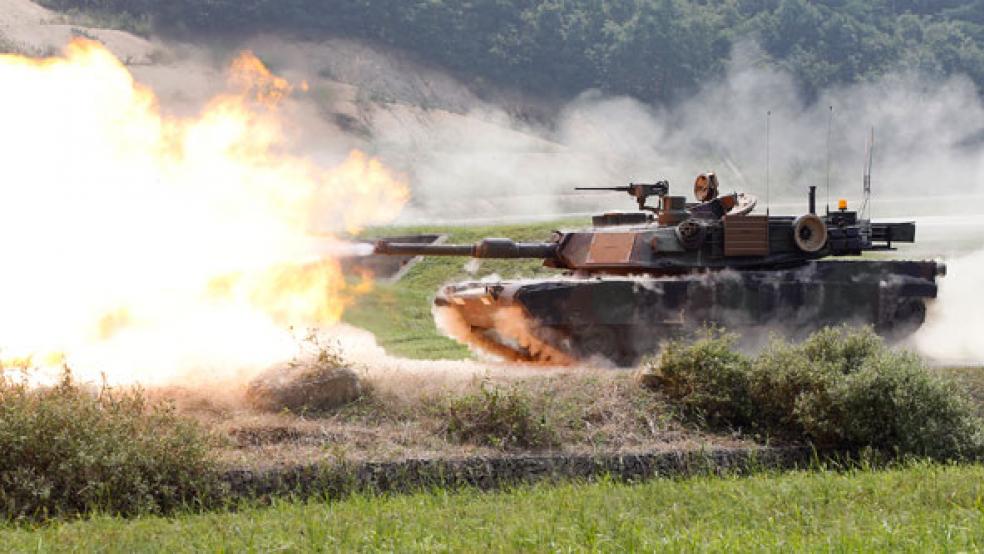President Obama’s decision on Tuesday to end an arms freeze against Egypt, a longtime ally, will clear the way for delivery of a panoply of powerful and pricey weapons, including F-16 aircraft, Harpoon missiles and M1A1 Abrams tanks.
President Abdel Fattah el-Sisi of Egypt has fallen well short of correcting human rights violations that prompted the weapons freeze in October 2013, following the military overthrow of Egypt’s democratically elected government. Yet Obama appears more concerned now about assisting a key ally in confronting mounting militancy and terrorism in the Middle East.
Related: ISIS’s 10 Most Extreme Acts of Terror
The announcement that the Obama administration will support the full $1.3 billion of annual military assistance to Egypt was also a reminder of a reality that few officials would care to proudly proclaim: The U.S. reigns as the world’s leading arms merchant.
For years the U.S. military-industrial complex has provided the sophisticated hardware and firepower used in the global arms race, with Russia close behind. The U.S. has also closely tailored its military aid to try to get U.S.-manufactured weapons systems into the hands of its allies in a dangerous world.
“The selling of arms is an important element in American security assistance policy,” said Gordon Adams, a national security and defense expert at American University. Obama’s decision to lift the freeze on Egypt, he said, “is consistent with policy and it’s consistent with the U.S. becoming the No. 1 arms merchant to the world over the past decade.”
“The administration’s policy clearly is to throw in with strengthening the security forces of friendly states, and part of that is selling them arms — with our money in this case,” he added. “The Egyptians aren’t ponying up. We’re rotating the cash back in.”
Related: Obama Would Violate Budget Control Act with $34B More for Defense
According to the Stockholm International Peace Research Institute, the U.S. controlled 31 percent of the global market for weapons exports between 2010 and 2014, up from 29 percent in previous years. Russia trailed with 27 percent of the overall market, followed by China, Germany and France — each with 5 percent shares.
The Congressional Research Service estimates that global arms transfers rose from about $51 billion in 2004 to $85 billion in 2011, for a total of more than $500 billion over the eight-year period. The U.S. ranked first in worldwide arms transfer agreements to both developed and developing nations in 2011, with $66.3 billion in such agreements or 77.7 percent of the total. This was the highest total for single-year agreements in the history of the U.S. arms export program, according to the CRS report.
Six American companies placed among the top eight global firms based on defense-related revenues, according to Defense One. Lockheed Martin was first on the list with $35 billion in arms sales, with Boeing in second with $31 billion. Those two firms were followed by Raytheon ($22 billion), Northrop Grumman ($20 billion), General Dynamics ($19 billion) and United Technologies ($12 billion).
Terrence Guay Quartz, writing yesterday in Defense One, noted the U.S. has ranked No. 1 in military arms exports since the end of the Cold War, with many exports going to developed countries in Europe and Asia. However, the fast-rising wealth of emerging markets like India and countries in Africa are “gobbling up” a higher share of weapons and changing the arms market, especially as global instability increases year after year, he said.
Related: ISIS Delivers ‘Shock and Awe’ with Arms from U.S., China, and Russia
“The surge in conflicts involving non-state actors in the Middle East and Africa is also forcing more countries to stock up, creating more demand for tanks, advanced weapons systems, and especially light arms,” wrote Quartz, clinical professor of international business at the Smeal College of Business at Pennsylvania State University. “Regional rivalries between India and its neighbors Pakistan and China, as well as Saudi Arabia and the Gulf States with Iran, continue to simmer.”
Buyers in Asia and Oceania acquired the most U.S. weapons, or 48 percent, while recipients in the Middle East purchased 32 percent, according to Quartz. An additional 11 percent went to Europe. Russia’s biggest buyers, meanwhile, were India, China and Algeria, which consumed 60 percent of its arms exports.
Perhaps the most alarming recent development is that U.S.-manufactured weapons are falling into the hands of non-state actors such as al-Qaeda, ISIS and Boko Haram. While terrorist organizations like these rarely purchase tanks, heavy artillery and other weapons directly from the leading arms-exporting countries, such weapons are easily smuggled across borders or can be acquired from military forces defeated in battle.
Related: Yemen’s Civil War Forges Unholy Alliance Between al-Qaeda and ISIS
Among the vast array of weapons exported by the U.S. and Russia are tanks and self-propelled guns, field and air defense artillery, surface-to-air missiles, armored personnel carriers, aircraft carriers and destroyers. The list doesn’t stop there: Mine sweepers, submarines, guided missile patrol boats, helicopters and supersonic combat aircraft are also included, according to the Congressional Research Service.
Top Reads from The Fiscal Times:


